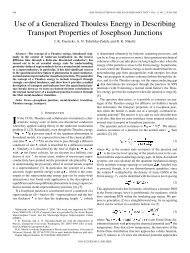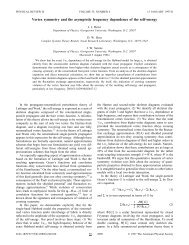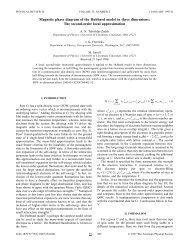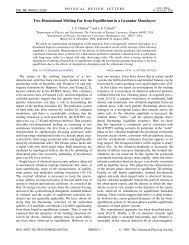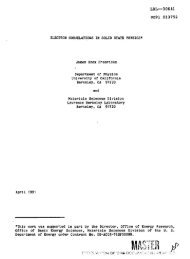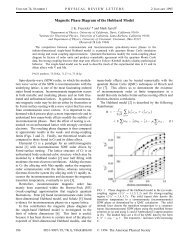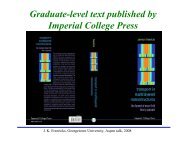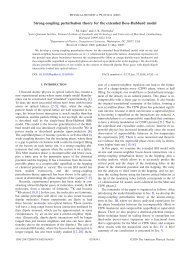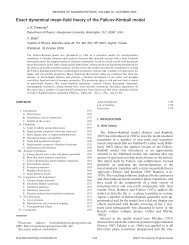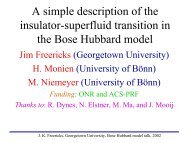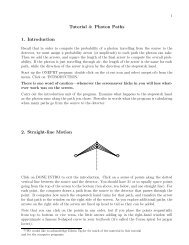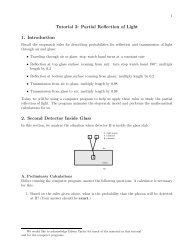Beyond Eliashberg superconductivity in MgB2 - Physics ...
Beyond Eliashberg superconductivity in MgB2 - Physics ...
Beyond Eliashberg superconductivity in MgB2 - Physics ...
You also want an ePaper? Increase the reach of your titles
YUMPU automatically turns print PDFs into web optimized ePapers that Google loves.
VOLUME 87, NUMBER 8 PHYSICAL REVIEW LETTERS 20AUGUST 2001<br />
FIG. 3. Fermi surfaces for two frozen-phonon patterns of E 2g<br />
symmetry with B displacements of 60.07 a.u.<br />
is needed to better elucidate the effect of anharmonicity<br />
and nonl<strong>in</strong>ear coupl<strong>in</strong>g on the superconduct<strong>in</strong>g properties<br />
of this material.<br />
We thank J. K. Freericks for helpful discussions. This<br />
work was supported by NSF under Grant No. DMR-<br />
9973225 and by ONR. A. Y. L. acknowledges support<br />
from the ASEE-U.S. Navy Faculty Sabbatical Program.<br />
where G i a i k, and a i are the three smallest lattice vectors.<br />
At the G po<strong>in</strong>t y k 0, and there are two doubly<br />
degenerate states. The bond<strong>in</strong>g pair forms the 2D Fermi<br />
surfaces, and the ma<strong>in</strong> effect of the E 2g phonons is to lift<br />
the degeneracy at G, thereby chang<strong>in</strong>g the overall splitt<strong>in</strong>g<br />
between the two subbands. This effect does not depend on<br />
the sign of the ionic displacement (the degeneracy is lifted<br />
either way) and thus is nonl<strong>in</strong>ear by def<strong>in</strong>ition. This is<br />
illustrated <strong>in</strong> Fig. 3 by the Fermi-surface plots for two opposite<br />
E 2g phonon patterns, both correspond<strong>in</strong>g to Q 1.<br />
One can see that while for the 3D sheets the coupl<strong>in</strong>g is<br />
mostly l<strong>in</strong>ear (changes of the Fermi surface are opposite),<br />
for the 2D cyl<strong>in</strong>ders it is mostly quadratic (changes are<br />
the same; cf. the undistorted Fermi surface <strong>in</strong> Ref. [4]).<br />
Nonl<strong>in</strong>ear EPC is also a likely source of anharmonicity:<br />
as discussed above, the contribution to the E 2g phonon<br />
self-energy from the EPC with the 2D FSs amounts to as<br />
much as 20 meV, as evidenced by the soften<strong>in</strong>g of this<br />
phonon at G. A sizable part of this soften<strong>in</strong>g probably<br />
comes from two-phonon processes. Quartic anharmonicity<br />
of the ion-ion <strong>in</strong>teraction arises <strong>in</strong> the fourth order <strong>in</strong><br />
the l<strong>in</strong>ear <strong>in</strong>teraction constant, but <strong>in</strong> the second order <strong>in</strong><br />
the nonl<strong>in</strong>ear one.<br />
In summary, we have presented a first-pr<strong>in</strong>ciples <strong>in</strong>vestigation<br />
of the electron-phonon coupl<strong>in</strong>g <strong>in</strong> MgB 2 . Interband<br />
anisotropy enhances the coupl<strong>in</strong>g constant from its<br />
isotropic dirty-limit value of l 0 sc 0.77 to an effective<br />
clean-limit value of lsc<br />
eff 1.01 for <strong>superconductivity</strong>.<br />
With v ln 56.2 meV, this lsc<br />
eff is arguably consistent<br />
with the measured T c of nearly 40 K. In the clean limit,<br />
we predict two different superconduct<strong>in</strong>g order parameters:<br />
a larger one on the 2D FSs and a smaller one (by<br />
approximately one-third) on the 3D FSs. S<strong>in</strong>ce current<br />
experiments suggest that MgB 2 is <strong>in</strong>deed <strong>in</strong> the clean<br />
limit, multiple gaps should be observable. There are h<strong>in</strong>ts<br />
of this <strong>in</strong> both the tunnel<strong>in</strong>g and thermodynamic data.<br />
The E 2g phonon mode <strong>in</strong>volv<strong>in</strong>g <strong>in</strong>-plane B motion provides<br />
the strongest coupl<strong>in</strong>g. We predict a harden<strong>in</strong>g of<br />
12% of this mode at the zone center below T c . In addition,<br />
this mode is highly anharmonic, and it may also<br />
have significant two-phonon coupl<strong>in</strong>g. The former likely<br />
reduces the l<strong>in</strong>ear EPC, while the latter <strong>in</strong>creases the total<br />
EPC. Both effects may contribute to the significant deviation<br />
of the total isotope coefficient from 0.5. Further work<br />
[1] J. Nagamatsu et al., Nature (London) 410, 63 (2001).<br />
[2] S. L. Bud’ko et al., Phys. Rev. Lett. 86, 1877 (2001).<br />
[3] Y. Wang et al., Physica (Amsterdam) 355C, 179 (2001);<br />
F. Bouquet et al., Phys. Rev. Lett. 87, 047001 (2001).<br />
[4] J. Kortus et al., Phys. Rev. Lett. 86, 4656 (2001).<br />
[5] P. Canfield et al., Phys. Rev. Lett. 86, 2423 (2001).<br />
[6] Y. Kong et al., Phys. Rev. B 64, 020501 (2001).<br />
[7] K.-P. Bohnen, R. Heid, and B. Renker, Phys. Rev. Lett. 86,<br />
5771 (2001).<br />
[8] G. Rubio-Boll<strong>in</strong>ger, H. Suderow, and S. Vieira, Phys. Rev.<br />
Lett. 86, 5582 (2001).<br />
[9] H. Schmidt et al., Phys. Rev. B 63, 220504 (2001).<br />
[10] S. V. Shulga et al., cond-mat/0103154.<br />
[11] H. Suhl, B. T. Matthias, and L. R. Walker, Phys. Rev. Lett.<br />
3, 552 (1959).<br />
[12] W. H. Butler and P. B. Allen, <strong>in</strong> Superconductivity <strong>in</strong> d-<br />
and f-band Metals, edited by D. H. Douglass (Plenum, New<br />
York, 1976).<br />
[13] I. I. Maz<strong>in</strong> et al., Physica (Amsterdam) 209C, 125 (1993).<br />
[14] T. Yildirim et al., cond-mat/0103469.<br />
[15] A. A. Quong and B. M. Kle<strong>in</strong>, Phys. Rev. B 46, 10 734<br />
(1992); A. Y. Liu and A. A. Quong, ibid. 53, 7575 (1996).<br />
[16] N. Troullier and J. L. Mart<strong>in</strong>s, Phys. Rev. B 43, 8861<br />
(1991).<br />
[17] E. L. Muetterties, The Chemistry of Boron and Its Compounds<br />
(Wiley, New York, 1967).<br />
[18] Neglect<strong>in</strong>g <strong>in</strong>terband scatter<strong>in</strong>g, it is not possible for an<br />
optic mode at q 0 to couple to electrons s<strong>in</strong>ce energy<br />
cannot be conserved. The contribution to the EPC from the<br />
region near G is estimated by assum<strong>in</strong>g a constant matrix<br />
element <strong>in</strong> this region and approximat<strong>in</strong>g the Fermi surface<br />
as two cyl<strong>in</strong>drical sheets [21].<br />
[19] R. Osborn et al., Phys. Rev. Lett. 87, 017005 (2001).<br />
[20] R. Zeyher and G. Zwicknagl, Solid State Commun. 66, 617<br />
(1988); Z. Phys. B 78, 175 (1990).<br />
[21] C. O. Rodriguez et al., Phys. Rev. B 42, 2692 (1990).<br />
[22] Current experiments [3] <strong>in</strong>dicate renormalization of 1.6, but<br />
the LDA may overestimate the DOS by 10% 15%. The<br />
overestimation of NMR relaxation rates by the LDA provides<br />
<strong>in</strong>direct evidence of this [E. Pavar<strong>in</strong>i (unpublished)].<br />
[23] P. B. Allen and R. C. Dynes, Phys. Rev. B 12, 905 (1975).<br />
[24] D. Stroud, Phys. Rev. B 12, 3368 (1975).<br />
[25] A. E. Kark<strong>in</strong> et al., cond-mat/0103344.<br />
[26] In Ref. [8], where high-quality spectra with a gap 3 times<br />
smaller than the BCS value were obta<strong>in</strong>ed, a unique procedure<br />
was used for sample preparation, which may have<br />
preferentially oriented <strong>in</strong>dividual microcrystals.<br />
087005-4 087005-4




